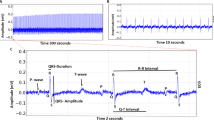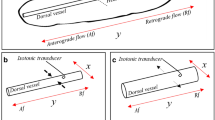Summary
The larvae of the North African winter breeders Broscus laevigatus and Orthomus atlanticus survive a temperature of 30° C and a relative atmospheric humidity of 75% only briefly. The first larval instar of O. atlanticus is particularly sensitive to dehydration. It does not live longer than the corresponding larval instar of the Central European species Pterostichus angustatus Dft.
Examinations at a temperature of 20° C and a relative atmospheric humidity of 75% proved that the first larval instar of Br. laevigatus is well adapted to these conditions and on average remains alive for 121.7 hours, as against 19.6 hours at a temperature of 30° C. This is regarded as adaptability to the short periods of drought which still occur at the beginning of the rainy season. In their first stage the larvae of O. atlanticus die after as little as 4.5 hours.
The two species develop at a low temperature which corresponds to the average winter temperature in the Cyrenaika (Libya, North Africa). Susceptibility to drought at high temperatures and the absence of the low temperatures they need for their development prevent Br. laevigatus and O. atlanticus from breeding during the North African summer.
As the larvae of O. atlanticus in their first stage of development are susceptible to dehydration, reproduction in this species is mainly limited to the winter. Its different stages of development withstand high temperatures better than those of B. laevigatus. On account to the poor adaptability of its larval stages to high temperatures B. laevigatus is forced to propagate during the winter. Low temperatures (14° C) during the first larval instars accelerate the development of the third instar of the two species at a temperature of 20° C and reduce the mortality rate of O. atlanticus considerably. The accelerated development caused by low temperatures reflects in a somewhat lesser degree the larval diapause of the autumn breeders that live in the temperature zones.
Zusammenfassung
Die Larven der nordafrikanischen “Wintertiere” Broscus laevigatus Dej. und Orthomus atlanticus Fairm. leben bei 30° C unter 75,5% rel. Luftfeuchtigkeit nur relativ kurze Zeit. Besonders empfindlich gegen Austrocknung ist das 1. Larvenstadium von O. atlanticus. Es lebt nicht länger als das entsprechende Larvenstadium der mitteleuropäischen Art Pterostichus angustatus Dft.
Untersuchungen, die bei 20° C und 76% rel. Luftfeuchtigkeit mit dem 1. Larvenstadium von B. laevigatus, O. atlanticus und P. angustatus durchgeführt wurden, zeigten, daß das 1. Larvenstadium von B. laevigatus an diese Bedingungen gut angepaßt ist und 121,7 h im Durchschnitt gegenüber 19,6 h bei 30° C überlebt. Dies wird als Anpassung an die kürzeren Trockenperioden gedeutet, die zu Beginn der Regenzeit noch auftreten. Das 1. Larvenstadium von O. atlanticus stirbt bereits nach 4,5 h. Es lebt damit nur wenig länger als das 1. Larvenstadium von P. angustatus (4,0 h).
B. laevigatus und O. atlanticus besitzen eine niedrige Entwicklungstemperatur, die mit der durchschnittlichen Wintertemperatur von 14° C in der Cyrenaika (Libyen, Nordafrika) übereinstimmt.
Empfindlichkeit gegen Trockenheit und gestörte Entwicklung bei hohen Temperaturen verhindern die Fortpflanzung von B. laevigatus und O. atlanticus im nordafrikanischen Sommer. Die Fortpflanzung von O. atlanticus wird hauptsächlich durch die Empfindlichkeit des 1. Larvenstadiums gegen Austrocknung auf den Winter beschränkt. Hohen Temperaturen gegenüber sind seine Entwicklungsstadien toleranter als die von B. laevigatus. B. laevigatus wird vor allem durch die geringe Toleranz seiner Larvenstadien gegenüber hohen Temperaturen zur Winterfortpflanzung gezwungen.
Einwirkung niedriger Temperaturen (14° C) auf die ersten Larvenstadien verkürzt die Entwicklung des 3. Larvenstadiums unter 20°C bei beiden Arten und setzt bei O. atlanticus die Mortalität stark herab. In dieser Entwicklungsbeschleunigung durch Einwirkung niedriger Temperaturen läßt sich die Larvaldiapause der Herbsttiere aus den gemäßigten Breiten in abgeschwächter Form wiedererkennen.
Similar content being viewed by others

Literatur
Krehan, I.: Die Steuerung von Jahresrhythmik und Diapause bei Larval-und Imagoüberwinterern der Gattung Pterostichus (Col., Carab.). Oecologia (Berl.) 6, 58–105 (1970).
Larsson, S. G.: Entwicklungstypen und Entwicklungszeiten der dänischen Carabiden. Entom. Meddelels. 20, 275–560 (1939).
Paarmann, W.: Vergleichende Untersuchungen über die Bindung zweier Carabidenarten (P. angustatus Dft. und P. oblongopunctatus F.) an ihre verschiedenen Lebensräume. Z. wiss. Zool. 174, 83–176 (1966).
Paarmann, W.: Untersuchungen über die Jahresrhythmik von Laufkäfern (Coleoptera, Carabidae) in der Cyrenaika (Libyen, Nordafrika). Oecologia (Berl.) 5, 325–333 (1970).
Rudolph, R.: Ökethologische und funktionsmorphologische Untersuchung an Nebria complanata L. (Coleoptera, Carabidae). forma et functio 2, 189–237 (1970).
Thiele, H. U.: Experimentelle Untersuchungen über die Ursachen der Biotopbindung bei Carabiden. Z. Morph. Ökol. Tiere 53, 387–452 (1964).
Thiele, H. U.: The control of larval hibernation and of adult aestivation in the carabid beetles Nebria brevicollis F. and Patrobus atrorufus Stroem. Oecologia (Berl.) 2, 347–361 (1969).
Thiele, H. U.: Die Steuerung der Jahresrhythmik von Carabiden durch exogene und endogene Faktoren. Zool. Jb. System, Ökol. u. Geogr. 98, 341–371 (1971).
Thiele, H. U., Krehan, I.: Experimentelle Untersuchungen zur Larvaldiapause des Carabiden Pterostichus vulgaris. Ent. exp. and appl. 12, 67–73 (1969).
Walter, H., Lieth, H.: Klimadiagramm Weltatlas. Jena: Gustav Fischer 1960.
Winston, P. W., Bates, D. H.: Saturated solutions for the control of humidity in biological resarch. Ecology 41, 232–237 (1960).
Author information
Authors and Affiliations
Additional information
Herrn Dr. E. Gersdorf möchte ich an dieser Stelle für die Beschaffung der Elterntiere meiner O. atlanticus-Zucht und Herrn Prof. Dr. H. Schweiger für die Bestimmung dieser Art herzlich danken. Die Untersuchungen wurden von der Deutschen Forschungsgemeinschaft unterstützt.
Rights and permissions
About this article
Cite this article
Paarmann, W. Bedeutung der Larvenstadien für die Fortpflanzungsrhythmik der Laufkäfer Broscus laevigatus Dej. und Orthomus atlanticus Fairm. (Col., Carab.) aus Nordafrika. Oecologia 13, 81–92 (1973). https://doi.org/10.1007/BF00379621
Received:
Issue Date:
DOI: https://doi.org/10.1007/BF00379621



